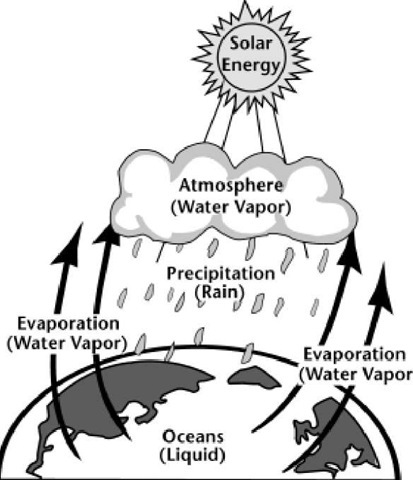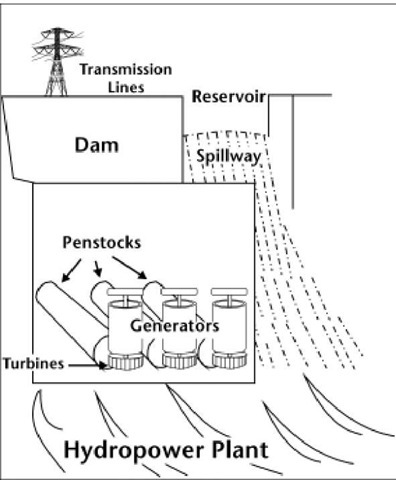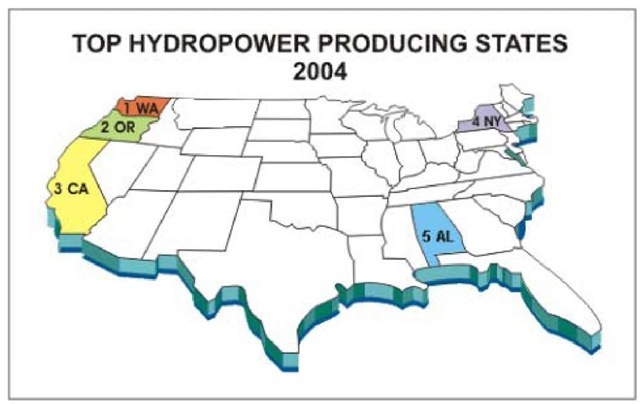Energy from Moving Water
HYDROPOWER GENERATES ELECTRICITY
Of the renewable energy sources that generate electricity, hydropower is the most often used. It accounted for 7 percent of total U.S. electricity generation and 75 percent of generation from renewables.
The Water Cycle
It is one of the oldest sources of energy and was used thousands of years ago to turn a paddle wheel for purposes such as grinding grain. Our nation’s first industrial use of hydropower to generate electricity occurred in 1880, when 16 brush-arc lamps were powered using a water turbine at the Wolverine Chair Factory in Grand Rapids, Michigan. The first U.S. hydroelectric power plant opened on the Fox River near Appleton, Wisconsin, on September 30, 1882. Until that time, coal was the only fuel used to produce electricity. Because the source of hydropower is water, hydroelectric power plants must be located on a water source. Therefore, it wasn’t until the technology to transmit electricity over long distances was developed that hydropower became widely used.
HOW HYDROPOWER WORKS
Understanding the water cycle is important to understanding hydropower. In the water cycle –
• Solar energy heats water on the surface, causing it to evaporate.
• This water vapor condenses into clouds and falls back onto the surface as precipitation.
The water flows through rivers back into the oceans, where it can evaporate and begin the cycle over again.
Mechanical energy is derived by directing, harnessing, or channeling moving water. The amount of available energy in moving water is determined by its flow or fall. Swiftly flowing water in a big river, like the Columbia River along the border between Oregon and Washington, carries a great deal of energy in its flow. So, too, with water descending rapidly from a very high point, like Niagara Falls in New York. In either instance, the water flows through a pipe, or penstock, then pushes against and turns blades in a turbine to spin a generator to produce electricity. In a run-of-the-river system, the force of the current applies the needed pressure, while in a storage system, water is accumulated in reservoirs created by dams, then released when the demand for electricity is high. Meanwhile, the reservoirs or lakes are used for boating and fishing, and often the rivers beyond the dams provide opportunities for whitewater rafting and kayaking. Hoover Dam, a hydroelectric facility completed in 1936 on the Colorado River between Arizona and Nevada, created Lake Mead, a 110-mile-long national recreational area that offers water sports and fishing in a desert setting.
WHERE HYDROPOWER IS GENERATED
Over one-half of the total U.S. hydroelectric capacity for electricity generation is concentrated in three States (Washington, California and Oregon) with approximately 27 percent in Washington, the location of the Nation’s largest hydroelectric facility – the Grand Coulee Dam.
It is important to note that only a small percentage of all dams in the United States produce electricity. Most dams were constructed solely to provide irrigation and flood control.
HYDROPOWER AND THE ENVIROMENT
Some people regard hydropower as the ideal fuel for electricity generation because, unlike the nonrenewable fuels used to generate electricity, it is almost free, there are no waste products, and hydropower does not pollute the water or the air. However, it is criticized because it does change the environment by affecting natural habitats. For instance, in the Columbia River, salmon must swim upstream to their spawning grounds to reproduce, but the series of dams gets in their way. Different approaches to fixing this problem have been used, including the construction of “fish ladders” which help the salmon “step up” the dam to the spawning grounds upstream.
Cheap Energy vs the Environment The Case of Hydroelectric Power
Historical Growth of Hydroelectric power:
• Currently Hydro power is 7% of the total US Energy Budget. This has been going decreasing with time
• This varies considerably with region in the US due to the availability of freely flowing streams
• Dam building really was initiated in the 1930′s as part of a public works program to combat the depression
• Low cost per KWH (see below) caused exponential increase of dam building from 1950-1970 (lots of this on the Columbia)
• Since 1970 hydroproduction has levelled off and therefore becomes an increasingly smaller percentage of the US energy budget.
Hydropower is a natural renewable energy source as it makes use of The Hydrological Cycle:
Hydropower production is sensitive to secular evolution of weather; seasonal snowpacks, etc, etc. Long term droughts (10 years or so) seem to occur frequently in the West About 30% of the hydropotential in the US has been tapped to date
Why is Hydro so attractive?
BECAUSE ITS CHEAP! for the consumer B®1average price in the PNW is around 4 cents per KWH this is 3 times less than the national average!
• Low cost to the consumer reflect relatively low operating costs of the Hydro Facility. Most of the cost is in building the dam
• Operating costs about 0.6 cents per KWH
• Coal Plant averages around 2.2 cents per KWH B
* which reflects costs of mining, transport and distribution.
Energy density in stored elevated water is high:
So one liter of water per second on a turbine generates 720 watts of power. If this power can be continuously genreated for 24 hours per day for one month then the total number of KWH per month is then:
720 watts x 24 hours/day x 30 days/month = 518 Kwh/month.
Power generating capacity is directly proportional to the height the water falls. For a fall of say only 3 m, 30 times less electricity would be generated (e.g. 17 Kwh/month) – but this is just for a miniscule flow rate of 1 kg/sec.
Capacities of some large dams:
|
Grand Coulee |
1942 |
6500 |
MW |
|
John Day |
1969 |
2200 |
MW |
|
Niagara (NY) |
1961 |
2000 |
MW |
|
The Dalles |
1957 |
1800 |
MW |
|
Chief Joseph |
1956 |
1500 |
MW |
|
McNary |
1954 |
1400 |
MW |
|
Hoover |
1936 |
1345 |
MW |
|
Glen Canyon |
1964 |
950 |
MW |
|
Three Gorges |
2000 |
18000 Mw |
|
Pacific Northwest has 58 hydroelectric dams 1^63% of total electricity generated. Most of the rest comes from coal fired steam plants (e.g. Centralia Washington).
Note, the Trojan Nuclear Power Plant was relatively easy to shut down because replacement power was immediately available.
Again the main advantages of Hydro are a) its renewable and b) there is a lot of energy available:
Some Real Disadvantages:
Hydroelectric Power – The Risks:
Dams are frequently located upstream from major population centers:
• 1918–1958: 33 Major dam failures resulting in 1680 documented fatalities
• 1959–1965: 9 major dams failed throughout the world
• 1976: Teton Dam failure in Idaho
• Most of the dams on the columbia have been built since 1950 and are not close to their failure points
• The Salmon Problem:
Extremely Emotional Issue –icon of the PNW
Some Federal Dam Licenses can now be lost because of salmon migration problems
■ Some studies suggest Federal dams are mostly resonsible for drop from 16 million to 300,000 wild fish per year
■ Actual Salmon Count data is available for these dam sites:
■ John Day Dam
■ Bonneville Dam
■ Lower Monumental Dam
■ McNary Dam
■ The Dalles
■ Ice Harbor Dam
■ Lower Granite Dam
■ Little Goose Dam
Estimated that to improve migration, utility rates will rise in the PNW by 8% o There are lots of other factors at work as well:
■ El Nino
■ Agressive Fishing
■ Poor logging practices and increased soil erosion
Note that reservoirs offer expanded habitat for geese, pelicans, eagles, osprey. They also help with flood control thus minimizing soil erosion in the watershed.
Adverse effects of dams on salmon:
• migratory barrier
• killed in turbines (especially young ones swimming downstream)
• supersaturation of air in water (high pressure of water falling down forces air into the solution)
• reduced oxygen content if river flow is reduced (summer) due to separation of warm and cold water; cold water doesn’t mix to be aerated (this is mostly a problem in the Tennesee Valley)
Solutions:
• Build fish “passages” to direct them towards tributaries this has proven successful for trout in Oregon
• Better turbine design and screen systems can help eliminate fishkill on the downstream migration
• Minimize turbulence in the operation of the turbine



![tmp87-22_thumb[1] tmp87-22_thumb[1]](http://lh4.ggpht.com/_LenCZlyza20/TRJDf_eys3I/AAAAAAAAGEE/rvuHKSHw5WQ/tmp8722_thumb1_thumb2.jpg?imgmax=800)
